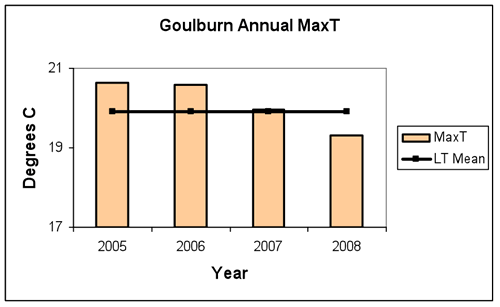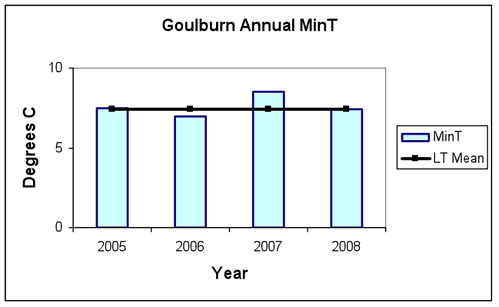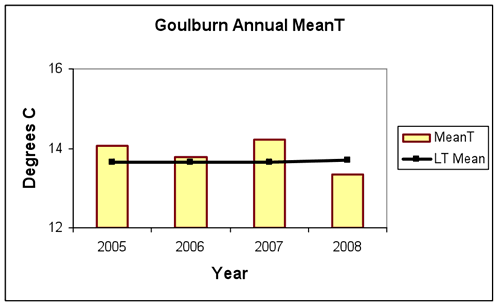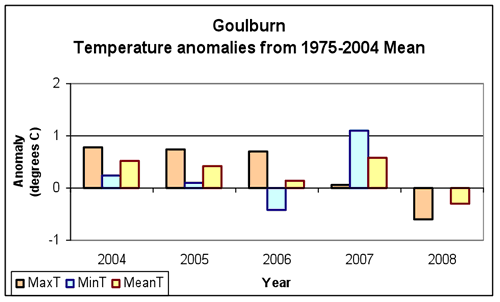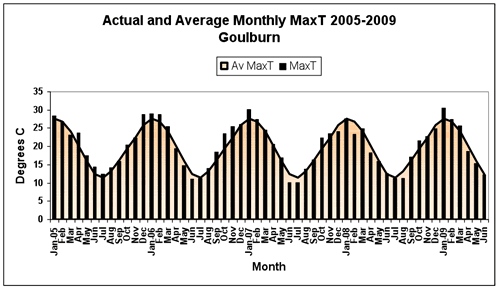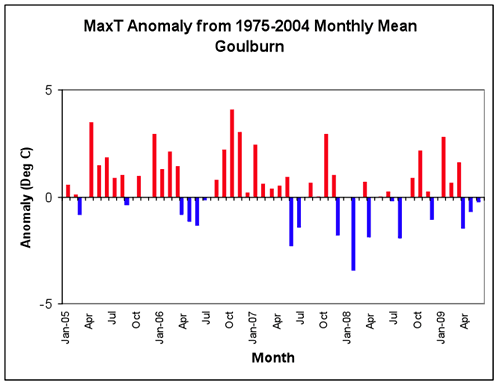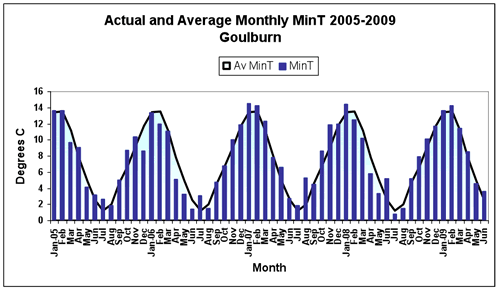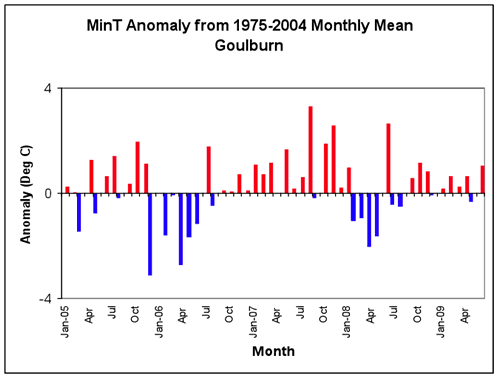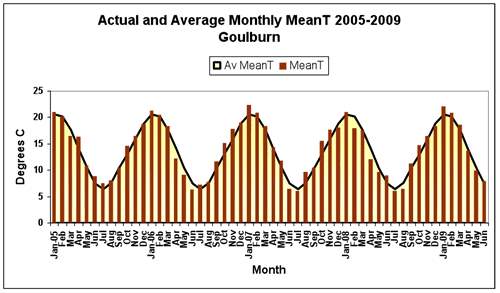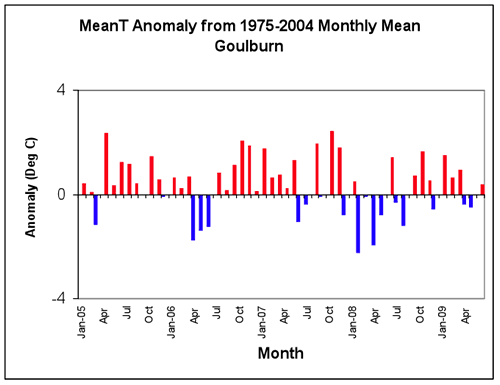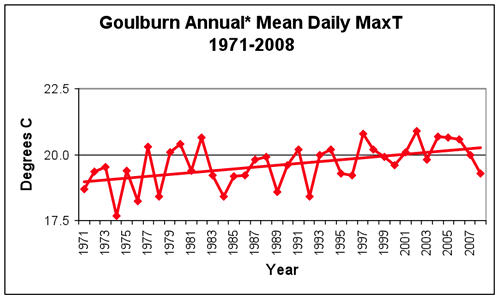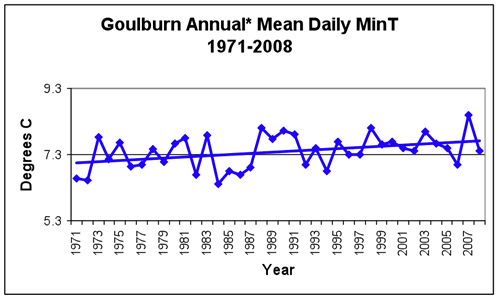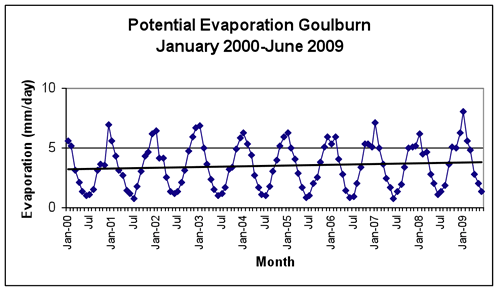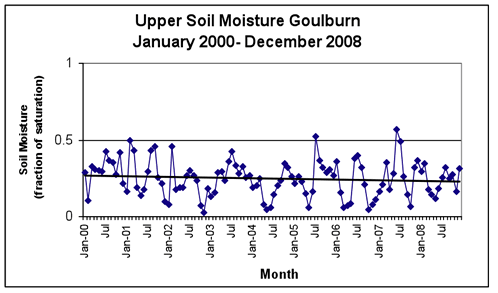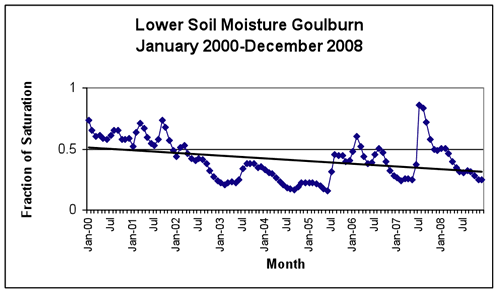Goulburn-Mulwaree
Please note: Text or data highlighted in this colour represent an update to this indicator for the period 2008/09. All temperature figures have been updated on this page. Evaporation and Soil Moisture have also been included in this update.
Temperature Analysis
Temperature data at Goulburn during the reporting period were collected at the TAFE (Bureau of Meteorology Station No. 070263). The automatic weather station at Goulburn Airport (No. 070330) was also used to derive data where there were missed observations. There is a continuous data record at this site from 1991 to the present (see Appendix 1 for more details). A complete longer-term dataset has now been developed for Goulburn using the high correlations with both maximum and minimum temperatures at Taralga (refer to Appendix 3 for details).
Note that in the following analyses temperatures for individual months are compared to the long-term average (or climatology) from 1975-2004. A 30-year period is used to calculate climatological averages to conform with World Meteorological Organisation practice; this takes into account year-to-year variations and less frequent events such as El Niño or La Niña. This particular 30-year period is used in this analysis because it is the period with the best temperature data availability across the Australian Capital Region.
Annual daily maximum temperatures at Goulburn for the period 2005-2008 were above average for 2005 and 2006, average for 2007 and below average for 2008 (Table 1 and Figure 1). Annual daily minimum temperatures were average in 2005 and 2008, below average in 2006 and above average in 2007. Overall, mean daily temperatures were slightly above average for 2005-2007 and below average for 2008 (calculated as the average of the maximum and minimum temperature each day).
2005 |
2006 |
2007 |
2008 |
|
|---|---|---|---|---|
| Mean Daily Maximum Temperature | 20.6 |
20.6 |
20.0 |
19.3 |
| Anomaly (oC) | 0.7 |
0.7 |
0.1 |
-0.4 |
| Anomaly (%) | 4% |
4% |
0% |
-2% |
| Mean (1975-2004) | 19.7 |
|||
| Mean Daily Minimum Temperature | 7.5 |
7.0 |
8.5 |
7.4 |
| Anomaly (oC) | 0.1 |
-0.4 |
1.1 |
0 |
| Anomaly (%) | 1% |
-6% |
15% |
0% |
| Mean (1975-2004) | 7.4 |
|||
| Mean Daily Mean Temperature | 14.1 |
13.8 |
14.2 |
13.4 |
| Anomaly (oC) | 0.4 |
0.1 |
0.6 |
-0.3 |
| Anomaly (%) | 3% |
1% |
4% |
-2% |
| Mean (1975-2004) | 13.7 |
|||
|
In the 54-month period January 2005- June 2009 there were 31 months (65%) in which the monthly maximum temperatures were above the long term average (Figure 2). This four year period had considerably warmer monthly average daytime temperatures than the long-term mean, particularly between July 2006 and January 2008, particularly over the summer months. Maximum temperature anomalies were highest in October 2006 (4.1oC above the monthly average), whereas in February 2008 the average daily maximum temperature was 3.4oC below the monthly average.
For minimum temperatures there were 30 months in which the temperatures were above average. Nights were particularly warm between September 2006 and January 2008 during which time there was only one month of below average minimum temperatures. Minimum temperature anomalies were highest in August 2007 (3.3oC above the monthly average), whereas in December 2005 the average daily minimum temperature was 3.1oC below the monthly mean.
Overall, the daily mean temperatures reflect the warmer than average maximum and minimum temperatures with 36 months (67%) being average or above average. For the period January 2005-January 2008, there were only 9 months that experienced below average mean temperatures.
|
Long-Term Climate Trend
It is useful to compare recent climate observations with a longer record in order to provide a context for recent events. Temperature records at Goulburn are incomplete during the period 1971-1991, and the location of the site changed for the period 1975-1978. There are also several missing months for some years that result in no annual data being available for those years. Continuous data are available only from 1991. Temperature trends prior to 1991 must therefore be interpreted with caution (see appendix 3).
Both maximum and minimum temperatures at Goulburn appear to have been increasing steadily since 1971 (Figure 3), although 2008 has been the coolest year for some time. Note that an El Niño event occurred in 2006/2007; temperatures tend to be above average during these events, particularly in spring and summer. The cooler conditions in 2008 coincided with a La Niña event.
|
Evaporation and Soil Moisture
Evaporation and soil moisture are important components of the moisture balance in the environment. Potential evaporation (the amount of moisture evaporated from an open water surface under prevailing conditions) occurs as a consequence of a combination of factors including incoming solar radiation, temperature, wind and the humidity of the air. The balance among the factors controls the amount of potential evaporation, so that an increase in solar radiation or temperature (which would cause evaporation to increase if all other factors remained unchanged) might be offset by a decrease in wind (which would cause evaporation to decrease). Soil moisture reflects the interaction between rainfall and evaporation, and provides an indication of the amount of moisture available for plant growth.
The variation in potential evaporation at Goulburn for the period 2000-2008 is illustrated in Figure 4. There is strong seasonal variation between summer and winter, with low values in winter and high values in summer. Potential evaporation over this period shows little overall trend or change from year to year, except during the 2008-9 summer when potential evaporation increased.
|
Soil moisture variations at Goulburn in the upper and lower layers in the period 2000-2008 are illustrated in Figure 5. The impact of rainfall on the upper level soil moisture profile is evident in the relatively large and rapid fluctuations within the time period, which closely mirror the variability of rainfall at Goulburn. The lower level soil moisture shows the effects of the extended dry period since 2000; there is an overall decline in the lower soil moisture, with any increases in moisture being relatively abrupt (following larger rainfall events, for example in 2008) followed by longer periods of drying. The time lag in changes to the lower level soil moisture following rain events is also evident.
|
About the data
Evaporation and soil moisture data were extracted from the Australian Water Availability Project (AWAP) dataset, a jointly funded project developed by CSIRO Marine and Atmospheric Research (CMAR), the Bureau of Meteorology (BoM) and the Bureau of Rural Science (BRS) to monitor the terrestrial water balance of Australia. Upper level soil depth is considered to be to a depth of 0.2m while lower level soil depth is considered to be to between 0.2m and 1.5 m.
References
M.R. Raupach, P.R. Briggs, V. Haverd, E.A. King, M. Paget and C.M. Trudinger, 2009 Australian Water Availability Project (AWAP): CSIRO Marine and Atmospheric Research Component: Final Report for Phase 3. CAWCR Technical Report No. 013. 67 pp.
